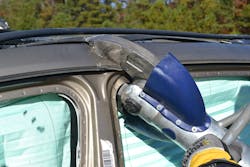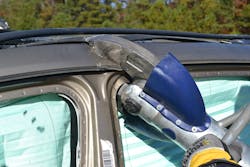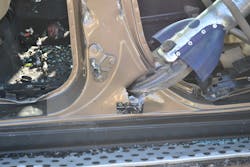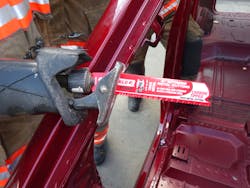University of Extrication: Use the Pie Cut Technique to Accomplish Total B-Pillar Removal
Topic: Total B-pillar removal
Objective: Accomplish total B-pillar removal by use of the “pie cut” technique
Task: Given a 4-door sedan vehicle for extrication training, the rescue team will simulate that the B-pillar consists of ultra-high strength steel and shall demonstrate total B-pillar removal by using the “pie cut” technique
When the B-pillar of a crash- damaged vehicle obstructs removal of trapped occupants, rescue teams typically accomplish total B- pillar removal, a tactic that is most commonly completed with a power cutter, a reciprocating saw or a good-quality air chisel tool.
What is important for rescuers to note is that it is likely that an inner layer of steel inside the B-pillar or the roof rail of a late model automobile will be ultra-high-strength steel (UHSS). This single layer, which might only be 1 mm thick, could literally shutdown your cutting effort unless you are prepared for the possibility of encountering these very strong steels.
The right tool for the job
If you are going to be successful against Boron steel with a power cutter, the tool must be capable of cutting through UHSS. Although some new models are capable, most older units are not. UHSS also may not be capable of being cut through with an air chisel. If you attack the B-pillar removal task with a reciprocating saw and Boron steel is present, you will need to reduce the speed of your saw to a medium stroke setting and utilize a Diablo-brand carbide-tipped blade.An old technique for modern times
Regardless of the tool you have, you first should strip the trim to make sure that where you are going to cut does not have any stored gas airbag inflators or other surprises waiting for you. When attacking a steel B-pillar for total removal, a pie cut technique is a valuable procedure to consider. This age-old rescue technique involves making cuts from multiple directions until a structural component, such as the B-pillar, is severed.
Pie cuts are effective in cutting through the roof rail of a vehicle, especially the area above the top of the B-pillar and the lowest area of a B-pillar near the rocker area. This technique can be used anytime the material being cut through is wider or longer than your cutting tool’s reach.
To be successful, the pie cuts need to join together due to the high megapascal (MPa) tensile strength ratings some steels have. The UHSS pillar or roof rail must be completely severed with the multiple pie cuts.
It is no longer feasible to make cuts from multiple directions into a vehicle’s structure and leave an uncut section in between. If you do this on a modern vehicle with UHSS and then simply try to tear the rest of the way, you might find that the Boron-type steels could be stronger than your rescue tool. That small, connected section might resist any tearing effort you can come up with and shut you and your tool down.
Practice creates habits
In rescue training, it is recommended that crews practice the pie cut technique even on older acquired vehicles with a mild steel pillar. Get in the habit of making cuts that join to each other so that the pillar—or whatever you are cutting—is completely severed. Once completed, remember to cover your sharps. If you created the hazard, then you should be responsible for protecting yourself and all others from it.
Regardless of what power rescue tools you have in your tool inventory, also get in the habit of using a reciprocating saw to accomplish tasks such as total B-pillar removal. Remember, the strokes-per-minute setting should be reduced to a medium speed to be most effective. It seems like an oxymoron concept, but a slower saw stroke will actually get the job done more quickly when Boron-type steels are present.
Pie Cut Reminders
- Strip the trim
- Connect the cuts
- Cover your sharps
About the Author
Ron Moore
RON MOORE, who is a Firehouse contributing editor, recently retired as a division chief with the McKinney, TX, Fire Department and now serves with Prosper, TX, Fire Rescue. He self-published the Vehicle Rescue 1-2-3 training manual and serves as the forum moderator for the extrication section of Firehouse.com . Moore can be contacted directly at [email protected].




